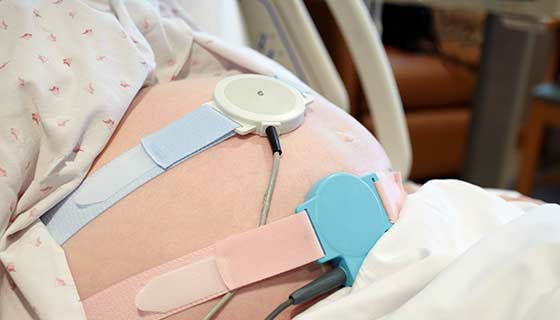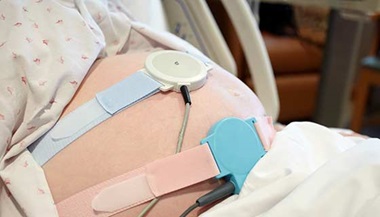Amniocentesis
What is an amniocentesis?
Amniocentesis is a procedure used to take out a small sample of the amniotic fluid for testing. This is the fluid that surrounds the fetus in pregnancy. Amniotic fluid is a clear, pale yellow fluid that:
-
Protects the fetus from injury
-
Protects against infection
-
Allows the baby to move and develop properly
-
Helps control the temperature of the fetus
Along with various enzymes, proteins, hormones, and other substances, the amniotic fluid contains cells shed by the fetus. These cells have genetic information that can be used to diagnose genetic disorders and open neural tube defects (ONTDs), such as spina bifida. This test may also be done to check for inherited gene defects and metabolic disorders based on the family history.
Amniotic fluid also contains other substances that give information about the fetus. This procedure may be done in late pregnancy to check fetal well-being and diagnose fetal health problems, such as infection. If a baby is expected to be delivered early, amniocentesis may be done to check for fetal lung maturity.
The fluid is sent to a lab so that the cells can grow and be analyzed. Results are most often ready in about 10 to 14 days, depending on the lab. Results from fetal lung maturity tests are ready within a few hours.
Why might I need an amniocentesis?
An amniocentesis is offered between the 15th and 20th weeks of pregnancy to those who are at greater risk for birth defects. It may also be used to follow-up when an earlier test suggests a problem.
Some conditions where an amniocentesis may be used for genetic and chromosome testing in the second trimester of pregnancy include:
-
Family history or previous child with a genetic disease or metabolic disorder, such as Down syndrome, cystic fibrosis, or Tay Sachs disease
-
Risk of open neural tube defects, such as spina bifida
-
Birth parent age over 35 years by the pregnancy due date
-
Abnormal maternal screening tests
-
Risk of a sex-linked genetic disease
Amniocentesis may be used in the third trimester of pregnancy to check for:
-
Fetal lung maturity when there is a potential for premature birth
-
Uterine infection
-
Rh disease
Your healthcare provider may have other reasons to recommend an amniocentesis.
What are the risks of an amniocentesis?
Some complications of an amniocentesis may include:
-
Cramping
-
Bleeding or leaking of amniotic fluid from the needle puncture site or the vagina
-
Infection
-
Miscarriage
-
Preterm labor
The risk of miscarriage is considered less than 1% after an amniocentesis in the second trimester of pregnancy. This is only slightly higher than the normal risk of miscarriage at this time in pregnancy.
Certain factors or conditions may interfere with an amniocentesis. These factors include:
-
Pregnancy earlier than 14 weeks
-
The position of the baby, placenta, amount of fluid, or birth parent's anatomy
-
Pregnancy with twins or other multiples will need fluid samples from each amniotic sac to study each baby
You may have other risks, depending on your condition. Be sure to discuss any concerns with your healthcare provider before the procedure.
How do I get ready for an amniocentesis?
-
Your healthcare provider will explain the procedure and you can ask questions.
-
You will be asked to sign a consent form that gives your permission to do the procedure. Read the form carefully and ask questions if anything is unclear.
-
Generally, there are no special limits on diet or activity before an amniocentesis.
-
Tell your healthcare provider if you are sensitive to or are allergic to any medicines, latex, tape, or anesthesia.
-
Tell your healthcare provider of all medicines (prescription and over-the-counter), herbs, vitamins, and supplements that you are taking.
-
Tell your healthcare provider if you have a history of bleeding disorders or if you are taking any anticoagulant (blood-thinning) medicines, aspirin, or other medicines that affect blood clotting. You may be told to stop these medicines before the procedure.
-
Make sure your healthcare provider knows if your blood type is Rh negative. During the amniocentesis, your blood cells can mix with those of the fetus. This can lead to Rh sensitization and breaking down of fetal red blood cells if you are Rh negative and your baby is Rh positive.
-
You may or may not be asked to empty your bladder right before the procedure. In early pregnancy, a full bladder helps move the uterus into a better position for the procedure. In later pregnancy, the bladder should be empty to lower the risk of puncture with the amniocentesis needle.
-
Follow any other instructions your provider gives you to get ready.
What happens during an amniocentesis?
An amniocentesis may be done on an outpatient basis or during a hospital stay. Procedures may vary depending on your condition and your doctor’s practices.
Generally, an amniocentesis follows this process:
-
You will need to undress completely, or from the waist down, and put on a hospital gown.
-
You will be asked to lie down on an exam table and place your hands behind your head.
-
Your blood pressure, heart rate, and breathing rate will be checked.
-
An ultrasound will be used to check the fetal heart rate; the position of the placenta, fetus, and umbilical cord; and to find a pocket of amniotic fluid.
-
Your abdomen will be cleaned with an antiseptic. You will be told not to touch the sterile area on your abdomen during the procedure.
-
You will feel a needle stick if a numbing drug is injected. This may cause brief stinging.
-
When your skin is numb, an ultrasound will be used to help guide a long, thin, hollow needle through your skin, into the uterus, and into the amniotic sac. This may be slightly painful. You may feel some cramping as the needle enters the uterus.
-
The doctor will withdraw a small amount of amniotic fluid into a syringe. The amount depends on the type of testing that will be done, but usually no more than an ounce is removed. Your body will make fluid to replace the amount taken out. You may feel a tugging or pulling feeling as the fluid is removed.
-
The needle will be removed.
-
The amniotic fluid will be put into a special light-protected container and sent to the lab.
-
A bandage will be placed over the needle site.
-
The fetus’ heart rate and your vital signs will be checked.
-
If you are Rh negative, you may be given Rhogam, a special injection that can prevent an Rh negative mother's antibodies from attacking Rh positive fetal blood cells.
What happens after an amniocentesis?
You and your fetus will be monitored for a time after the procedure. Your vital signs and the fetal heart rate will be checked regularly for an hour or longer.
The amniotic fluid sample will be sent to a genetics lab. Alpha-fetoprotein, a protein made by the fetus and present in the fluid, may be measured to rule out an open neural tube defect, such as spina bifida. Testing may also be done for other substances related to metabolic or genetic conditions. Depending on test results, counseling with a genetics specialist may be advised.
You may feel some cramping during or after the procedure. If you feel lightheaded, dizzy, or nauseated, tell the nurse. You may be told to rest on your left side.
After the test, rest at home and avoid strenuous activities for at least 24 hours, or as directed by your healthcare provider.
Tell your healthcare provider if you have any of the following:
-
Any bleeding or leaking of amniotic fluid from the needle puncture site or the vagina
-
Fever or chills
-
Severe belly pain, cramping, or both
-
Changes in the activity level of your fetus (if you are past 20 to 24 weeks of pregnancy)
Your healthcare provider may give you other instructions after the procedure, depending on your situation.
Next steps
Before you agree to the test or the procedure make sure you know:
-
The name of the test or procedure
-
The reason you are having the test or procedure
-
What results to expect and what they mean
-
The risks and benefits of the test or procedure
-
What the possible side effects or complications are
-
When and where you are to have the test or procedure
-
Who will do the test or procedure and what that person’s qualifications are
-
What would happen if you did not have the test or procedure
-
Any alternative tests or procedures to think about
-
When and how you will get the results
-
Who to call after the test or procedure if you have questions or problems
-
How much you will have to pay for the test or procedure





